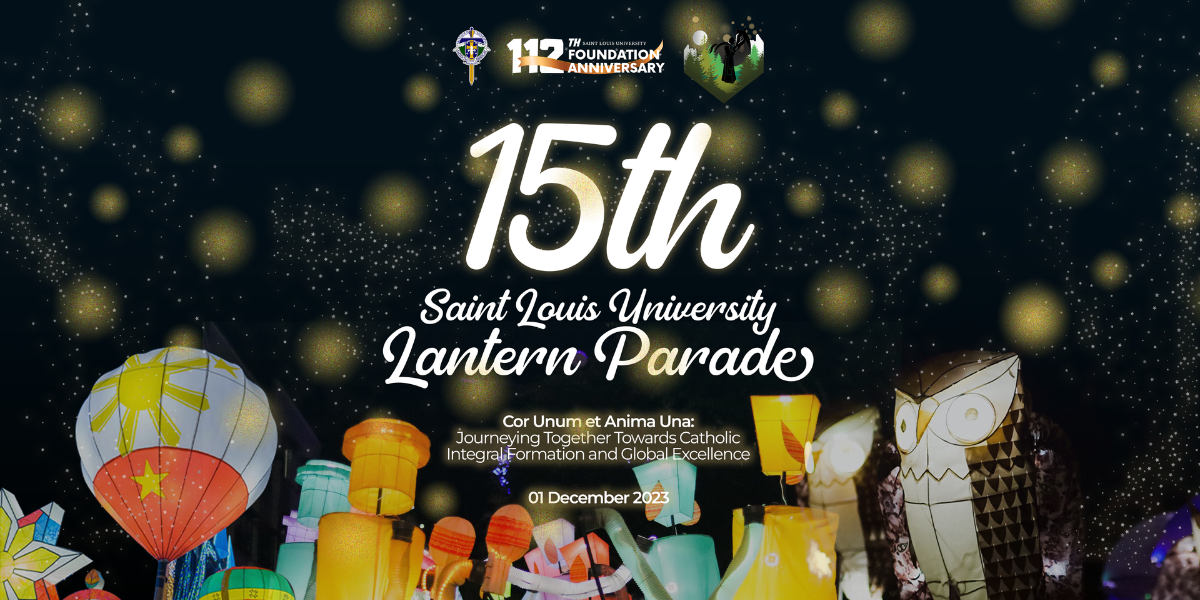Now in its 15th year, Saint Louis University continues its tradition of spreading light, warmth, and hope through its conduct of the annual December 1 spectacle, the SLU Lantern Parade.
With the theme, “Cor Unum Et Anima Una: Journeying Together Towards Catholic Integral Formation and Global Excellence”, the Louisian hallmark will once again illuminate the streets of Baguio City on 01 December 2023, with a breathtaking scene of unity, culture, and creativity.
The event, after the actual parade, will feature the live performances from each School representing the eight Congregatio Immaculati Cordis Mariae or the Congregation of the Immaculate Heart of Mary (CICM) provinces in the country namely: La Union, Nueva Vizcaya, Cebu, Manila, Bacolod, Agusan del Sur, Kalinga, and Cagayan.
For its 15th year, the Lantern Parade veered away from the usual display of Mother Lantern of each participating school, and instead, will showcase a grand University float.
Deeply rooted in the vision of the CICM, the 15th Lantern Parade float serves as a beacon of hope to the lived reality of CICM missionaries. Every detail put into the preparations of the parade is infused with this sentiment with the goal of uniting participants and onlookers in a shared sense of affinity and synodality.
Missions on Horseback: A Symbol of Missionary Zeal in the Philippines
Inspired by the motif, “Missions on Horseback”, the float envisioned a captivating design that pays tribute to the missionary legacy of Fr. Florimund Carlu, CICM, a significant figure in the history of Catholic missions in the Cordillera Administrative Region through the Congregation. This centerpiece is a symbol of missionary zeal in the Republic of the Philippines and is commemorative of the dedicated service and the enduring spirit of missionary work, highlighting the cultural and historical ties between CICM and Baguio City.
The Missionary: Fr. Florimund Carlu Figure
According to Sunstar, Fr. Carlu was known as a “Smiling Chaplain,” the “Priest on Horseback,” the “Man of Everybody,” the “Spiritual Director,” and the “Builder of the Baguio Cathedral,” as credited to him by the Baguio folks.
Fr. Carlu was one of nine CICM missionaries who arrived in the Philippines in 1907 with Fr. Seraphin Devesse, the founder of Saint Louis University. On 05 October 1913, Fr. Carlu succeeded Devesse as the pastor of Baguio City and took over the wooden churches and schools that the latter built. As the new parish priest of Baguio that time, he continued the administration of the two small churches and the two mission schools.
The Baguio Cathedral that he laboriously built in 1921 and completed in 1936, prominently bears his name today.
The Horse
The horse depicts a dynamic pose that conveys movement and purpose. As one of the most common forms of transportation in the Cordillera region, particularly in the Mountain Province in the early 1900s, the horse symbolizes the journey of faith of CICM missionaries that significantly grew out of Baguio City, moving towards the regions.
The Church Landscape: Baguio Cathedral
The missionary figure and the horse are placed in a landscaped setting, a Philippine church, that compliments the theme. It is symbolic of Baguio Cathedral and integrates elements of Filipino culture, particularly Baguio Culture, such as indigenous patterns on the horse’s saddle or the incorporation of local flora. This ensures that the artwork resonates with the local community and acknowledges the blending of cultures during the missionary journey, as well as CICM’s significant ministry milestones.
The church landscape is distinct from the stained glass designs of the SLU and CICM logos.
8 CICM Provinces
Another important design element to the collective theme and narrative of the 15th Lantern Parade is that each lantern design represents one of the eight CICM provinces: La Union, Nueva Vizcaya, Cebu, Manila, Bacolod, Agusan del Sur, Kalinga, and Cagayan.







